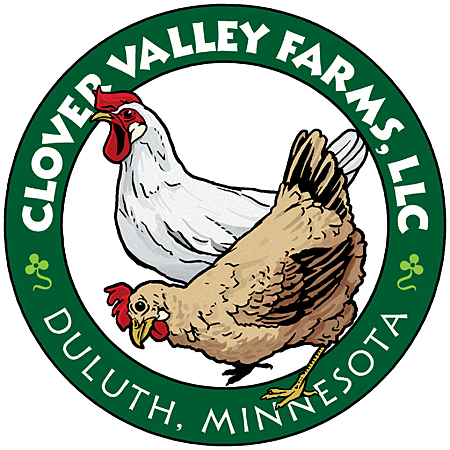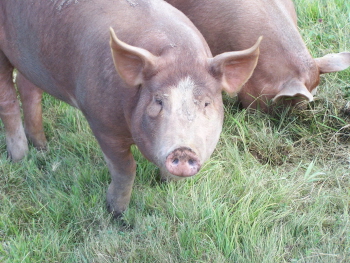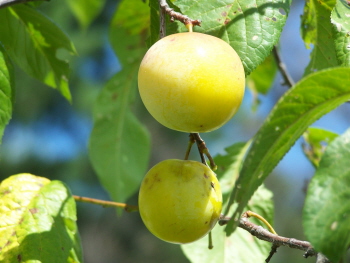Poultry Production
Layer Husbandry
Chicks of laying breeds spend 3 to 4 weeks in the brooder and are then kept in a 6’ x 12’ portable coop, which is moved semi-daily until the birds are about 4 months old. They are then integrated with the main flock in the hen coop, to which two hoop houses and two paddocks for rotational grazing are attached. Laying hens are generally processed and sold as stewing hens at 1½ years of age, after 6 months of growth followed by 1 year of laying. Males not kept as breeding roosters are typically processed at around 6 months of age.
 |
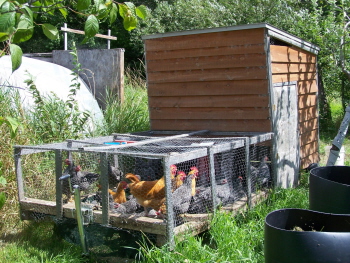 |
| Chicks in brooder |
Portable hen coop used for isolation breeding or birds in transition from brooder |
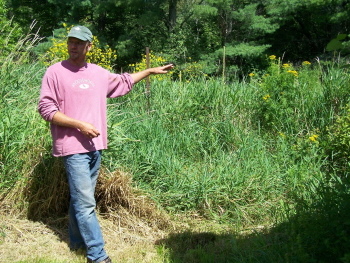 |
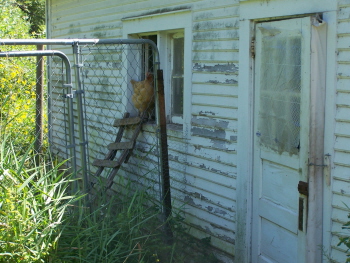 |
| Paddocks attached to hen coop |
|
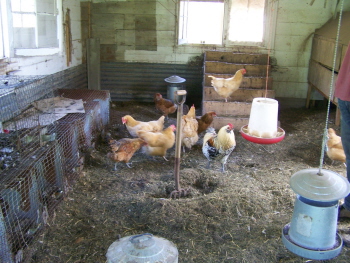 |
 |
| Inside of hen coop |
Hoop house attached to hen coop and under construction |
|
Spotlight on: Layer Husbandry Jeff and Cindy use the portable hen coop to hold young birds until they are ready for laying and integration with the main flock. The main flock is housed in a re-purposed, 24’ x 26’ garage. The hen coop includes steps and other perches, nest boxes, and isolation cages, where broody hens are kept for 4-5 days to break the cycle. There are three feeders, two founts (heated in winter), and a grit/oyster shell feeder suspended from the ceiling. They have had one predation event, where a mink got into the coop and took seven hens. The hen coop has a large door that Cindy and Jeff close in inclement weather or open to let the chickens forage around the homestead. They don’t generally allow layers to roam fully, or the hens would start laying eggs outside of their nest boxes. 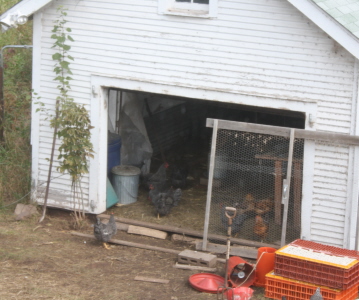 Mostly the chickens forage in two paddocks attached to the hen coop. The vegetation is thick and tall, which encourages them to wander and forage, though sometimes they lay eggs where they shouldn’t! Jeff and Cindy try to rotate use of the paddocks so that one can recover while the other is in use. They plant greens in the attached hoop house in the fall so the chickens can get sunlight and forage during the winter. They also provide fresh kitchen scraps in the winter, offer “habitat enhancements” including apples on sticks, twigs of balsam fir, and even the retired Christmas tree! They may start sprouting rye and oats in five-gallon buckets as an additional cold-weather supplement. 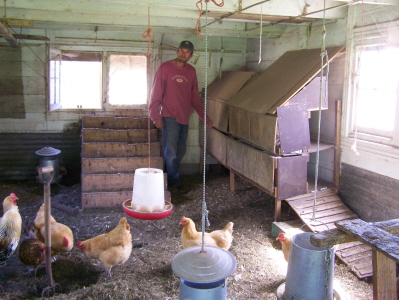
Jeff and Cindy provide supplemental lighting to keep hens laying year-round. When natural day length tapers off in the fall, they start using artificial lighting to ensure a minimum of 14 hours of light per day. They increase light by a few minutes every couple of weeks until February, when natural day length is increasing noticeably again, and keep it at 14 hours per day. They use compact fluorescents because they only need light, not heat, from the bulbs. The only heat provided in the uninsulated hen coop is that generated by the deep bedding system, which consists mostly of hay (round bales in winter) or grass (bagged lawn clippings in summer). They remove old bedding in the fall, leaving a few inches on top of the dirt floor to “prime the pump” of microbial activity, then add new bedding weekly through fall and winter. By spring the bedding is generally 18” to 24” deep. The composting process generates enough heat that Cindy and Jeff have seen it steaming in January! Manure from the chickens helps keep composting underway. The chickens also dig in the bedding for kitchen scraps, which helps to turn the compost over. Jeff and Cindy use a hand-held compost turner to aerate the pile almost daily, and they turn the bedding more thoroughly with a tined spade approximately twice a month to keep it fluffy and prevent “capping.” They installed metal roofing around the interior base of the coop to prevent the garage’s wooden walls from deteriorating. |
 |
 |
